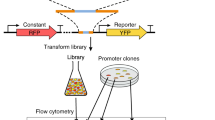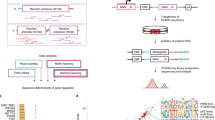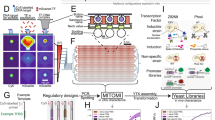Abstract
A challenge facing biology is to develop quantitative, predictive models of gene regulation. Eukaryotic promoters contain transcription factor binding sites of differing affinity and accessibility, but we understand little about how these variables combine to generate a fine-tuned, quantitative transcriptional response. Here we used the PHO5 promoter in budding yeast to quantify the relationship between transcription factor input and gene expression output, termed the gene-regulation function (GRF). A model that captures variable interactions between transcription factors, nucleosomes and the promoter faithfully reproduced the observed quantitative changes in the GRF that occur upon altering the affinity of transcription factor binding sites, and implicates nucleosome-modulated accessibility of transcription factor binding sites in increasing the diversity of gene expression profiles. This work establishes a quantitative framework that can be applied to predict GRFs of other eukaryotic genes.
This is a preview of subscription content, access via your institution
Access options
Subscribe to this journal
Receive 12 print issues and online access
$189.00 per year
only $15.75 per issue
Buy this article
- Purchase on Springer Link
- Instant access to full article PDF
Prices may be subject to local taxes which are calculated during checkout





Similar content being viewed by others
References
Cyert, M.S. Regulation of nuclear localization during signaling. J. Biol. Chem. 276, 20805–20808 (2001).
Vogel, K., Horz, W. & Hinnen, A. The two positively acting regulatory proteins PHO2 and PHO4 physically interact with PHO5 upstream activation regions. Mol. Cell. Biol. 9, 2050–2057 (1989).
Venter, U., Svaren, J., Schmitz, J., Schmid, A. & Horz, W. A nucleosome precludes binding of the transcription factor Pho4 in vivo to a critical target site in the PHO5 promoter. EMBO J. 13, 4848–4855 (1994).
Lam, F.H., Steger, D.J. & O'Shea, E.K. Chromatin decouples promoter threshold from dynamic range. Nature 453, 246–250 (2008).
Barbaric, S., Reinke, H. & Horz, W. Multiple mechanistically distinct functions of SAGA at the PHO5 promoter. Mol. Cell. Biol. 23, 3468–3476 (2003).
Steger, D.J., Haswell, E.S., Miller, A.L., Wente, S.R. & O'Shea, E.K. Regulation of chromatin remodeling by inositol polyphosphates. Science 299, 114–116 (2003).
Dhasarathy, A. & Kladde, M.P. Promoter occupancy is a major determinant of chromatin remodeling enzyme requirements. Mol. Cell. Biol. 25, 2698–2707 (2005).
Reinke, H. & Horz, W. Histories are first hyperacetylated and then lose contact with the activated PHO5 promoter. Mol. Cell 11, 1599–1607 (2003).
Boeger, H., Griesenbeck, J., Strattan, J.S. & Kornberg, R.D. Nucleosomes unfold completely at a transcriptionally active promoter. Mol. Cell 11, 1587–1598 (2003).
Adkins, M.W., Howar, S.R. & Tyler, J.K. Chromatin disassembly mediated by the histone chaperone Asf1 is essential for transcriptional activation of the yeast PHO5 and PHO8 genes. Mol. Cell 14, 657–666 (2004).
Adkins, M.W., Williams, S.K., Linger, J. & Tyler, J.K. Chromatin disassembly from the PHO5 promoter is essential for the recruitment of the general transcription machinery and coactivators. Mol. Cell. Biol. 27, 6372–6382 (2007).
Adkins, M.W. & Tyler, J.K. Transcriptional activators are dispensable for transcription in the absence of Spt6-mediated chromatin reassembly of promoter regions. Mol. Cell 21, 405–416 (2006).
Bintu, L. et al. Transcriptional regulation by the numbers: applications. Curr. Opin. Genet. Dev. 15, 125–135 (2005).
Rosenfeld, N., Young, J.W., Alon, U., Swain, P.S. & Elowitz, M.B. Gene regulation at the single-cell level. Science 307, 1962–1965 (2005).
Kalisky, T., Dekel, E. & Alon, U. Cost-benefit theory and optimal design of gene regulation functions. Phys. Biol. 4, 229–245 (2007).
Komeili, A. & O'Shea, E.K. Roles of phosphorylation sites in regulating activity of the transcription factor Pho4. Science 284, 977–980 (1999).
Springer, M., Wykoff, D.D., Miller, N. & O'Shea, E.K. Partially phosphorylated Pho4 activates transcription of a subset of phosphate-responsive genes. PLoS Biol. 1, e8 (2003).
Becskei, A., Kaufmann, B.B. & van Oudenaarden, A. Contributions of low molecule number and chromosomal positioning to stochastic gene expression. Nat. Genet. 37, 937–944 (2005).
Sheff, M.A. & Thorn, K.S. Optimized cassettes for fluorescent protein tagging in Saccharomyces cerevisiae. Yeast 21, 661–670 (2004).
Rizzo, M.A., Springer, G.H., Granada, B. & Piston, D.W. An improved cyan fluorescent protein variant useful for FRET. Nat. Biotechnol. 22, 445–449 (2004).
Shimizu, T. et al. Crystal structure of PHO4 bHLH domain-DNA complex: flanking base recognition. EMBO J. 16, 4689–4697 (1997).
Raser, J.M. & O'Shea, E.K. Control of stochasticity in eukaryotic gene expression. Science 304, 1811–1814 (2004).
Zhang, H. & Reese, J.C. Exposing the core promoter is sufficient to activate transcription and alter coactivator requirement at RNR3. Proc. Natl. Acad. Sci. USA 104, 8833–8838 (2007).
Barbaric, S., Munsterkotter, M., Goding, C. & Horz, W. Cooperative Pho2-Pho4 interactions at the PHO5 promoter are critical for binding of Pho4 to UASp1 and for efficient transactivation by Pho4 at UASp2. Mol. Cell. Biol. 18, 2629–2639 (1998).
Nourani, A., Utley, R.T., Allard, S. & Cote, J. Recruitment of the NuA4 complex poises the PHO5 promoter for chromatin remodeling and activation. EMBO J. 23, 2597–2607 (2004).
Jessen, W.J., Hoose, S.A., Kilgore, J.A. & Kladde, M.P. Active PHO5 chromatin encompasses variable numbers of nucleosomes at individual promoters. Nat. Struct. Mol. Biol. 13, 256–263 (2006).
Maerkl, S.J. & Quake, S.R. A systems approach to measuring the binding energy landscapes of transcription factors. Science 315, 233–237 (2007).
Gregory, P.D., Barbaric, S. & Horz, W. Analyzing chromatin structure and transcription factor binding in yeast. Methods 15, 295–302 (1998).
Schmid, A., Fascher, K.D. & Horz, W. Nucleosome disruption at the yeast PHO5 promoter upon PHO5 induction occurs in the absence of DNA replication. Cell 71, 853–864 (1992).
Nalley, K., Johnston, S.A. & Kodadek, T. Proteolytic turnover of the Gal4 transcription factor is not required for function in vivo. Nature 442, 1054–1057 (2006).
Yao, J., Munson, K.M., Webb, W.W. & Lis, J.T. Dynamics of heat shock factor association with native gene loci in living cells. Nature 442, 1050–1053 (2006).
Karpova, T.S. et al. Concurrent fast and slow cycling of a transcriptional activator at an endogenous promoter. Science 319, 466–469 (2008).
Segal, E., Raveh-Sadka, T., Schroeder, M., Unnerstall, U. & Gaul, U. Predicting expression patterns from regulatory sequence in Drosophila segmentation. Nature 451, 535–540 (2008).
Boeger, H., Griesenbeck, J. & Kornberg, R.D. Nucleosome retention and the stochastic nature of promoter chromatin remodeling for transcription. Cell 133, 716–726 (2008).
Cairns, B.R. Chromatin remodeling: insights and intrigue from single-molecule studies. Nat. Struct. Mol. Biol. 14, 989–996 (2007).
Urlinger, S. et al. Exploring the sequence space for tetracycline-dependent transcriptional activators: novel mutations yield expanded range and sensitivity. Proc. Natl. Acad. Sci. USA 97, 7963–7968 (2000).
Gari, E., Piedrafita, L., Aldea, M. & Herrero, E. A set of vectors with a tetracycline-regulatable promoter system for modulated gene expression in Saccharomyces cerevisiae. Yeast 13, 837–848 (1997).
Acknowledgements
We are especially grateful to F. Lam, Whitehead Institute, Cambridge, for the series of PHO5 promoter variant strains and protocols for ChIP and qPCR, and B. Margolin, University of California at San Francisco, for assistance with basic yeast techniques and helpful discussions. We thank members of the O'Shea laboratory, the Xie laboratory and the Bauer center as well as anonymous reviewers for advice and comments on the manuscript. We also thank A. van Oudenaarden, Massachusetts Institute of Technology, Cambridge, for the gift of the TETO7 plasmid. H.D.K. is supported by a CASI award from the Burroughs Wellcome Fund. E.K.O. acknowledges support from the US National Institutes of Health grant GM51377 and the Howard Hughes Medical Institute.
Author information
Authors and Affiliations
Contributions
H.D.K. and E.K.O. designed the research; H.D.K. performed the experiments; H.D.K. analyzed the data; H.D.K. and E.K.O. wrote the paper.
Corresponding author
Supplementary information
Supplementary Text and Figures
Supplementary Figures 1–6, Supplementary Methods and Supplementary Discussion (PDF 260 kb)
Supplementary Data
Fluorescence Data (XLS 4283 kb)
Rights and permissions
About this article
Cite this article
Kim, H., O'Shea, E. A quantitative model of transcription factor–activated gene expression. Nat Struct Mol Biol 15, 1192–1198 (2008). https://doi.org/10.1038/nsmb.1500
Received:
Accepted:
Published:
Issue Date:
DOI: https://doi.org/10.1038/nsmb.1500



